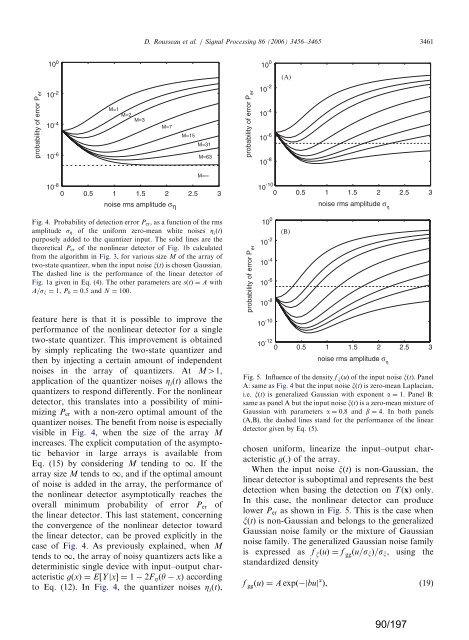a la physique de l'information - Lisa - Université d'Angers
a la physique de l'information - Lisa - Université d'Angers
a la physique de l'information - Lisa - Université d'Angers
Create successful ePaper yourself
Turn your PDF publications into a flip-book with our unique Google optimized e-Paper software.
probability of error P er<br />
10 0<br />
10 -2<br />
10 -4<br />
10 -6<br />
M=1<br />
M=2<br />
M=3<br />
M=7<br />
10<br />
0 0.5 1 1.5 2 2.5 3<br />
-8<br />
noise rms amplitu<strong>de</strong> ση feature here is that it is possible to improve the<br />
performance of the nonlinear <strong>de</strong>tector for a single<br />
two-state quantizer. This improvement is obtained<br />
by simply replicating the two-state quantizer and<br />
then by injecting a certain amount of in<strong>de</strong>pen<strong>de</strong>nt<br />
noises in the array of quantizers. At M41,<br />
application of the quantizer noises Z iðtÞ allows the<br />
quantizers to respond differently. For the nonlinear<br />
<strong>de</strong>tector, this trans<strong>la</strong>tes into a possibility of minimizing<br />
Per with a non-zero optimal amount of the<br />
quantizer noises. The benefit from noise is especially<br />
visible in Fig. 4, when the size of the array M<br />
increases. The explicit computation of the asymptotic<br />
behavior in <strong>la</strong>rge arrays is avai<strong>la</strong>ble from<br />
Eq. (15) by consi<strong>de</strong>ring M tending to 1. If the<br />
array size M tends to 1, and if the optimal amount<br />
of noise is ad<strong>de</strong>d in the array, the performance of<br />
the nonlinear <strong>de</strong>tector asymptotically reaches the<br />
overall minimum probability of error Per of<br />
the linear <strong>de</strong>tector. This <strong>la</strong>st statement, concerning<br />
the convergence of the nonlinear <strong>de</strong>tector toward<br />
the linear <strong>de</strong>tector, can be proved explicitly in the<br />
case of Fig. 4. As previously exp<strong>la</strong>ined, when M<br />
tends to 1, the array of noisy quantizers acts like a<br />
<strong>de</strong>terministic single <strong>de</strong>vice with input–output characteristic<br />
gðxÞ ¼E½YjxŠ ¼1 2F Zðy xÞ according<br />
to Eq. (12). In Fig. 4, the quantizer noises Z iðtÞ,<br />
ARTICLE IN PRESS<br />
M=15<br />
M=31<br />
M=63<br />
M=∞<br />
Fig. 4. Probability of <strong>de</strong>tection error Per, as a function of the rms<br />
amplitu<strong>de</strong> sZ of the uniform zero-mean white noises Z iðtÞ<br />
purposely ad<strong>de</strong>d to the quantizer input. The solid lines are the<br />
theoretical Per of the nonlinear <strong>de</strong>tector of Fig. 1b calcu<strong>la</strong>ted<br />
from the algorithm in Fig. 3, for various size M of the array of<br />
two-state quantizer, when the input noise xðtÞ is chosen Gaussian.<br />
The dashed line is the performance of the linear <strong>de</strong>tector of<br />
Fig. 1a given in Eq. (4). The other parameters are sðtÞ ¼A with<br />
A=sx ¼ 1, P0 ¼ 0:5 and N ¼ 100.<br />
D. Rousseau et al. / Signal Processing 86 (2006) 3456–3465 3461<br />
probability of error P er<br />
probability of error P er<br />
10 0<br />
10 -2<br />
10 -4<br />
10 -6<br />
10 -8<br />
10 -10<br />
10 0<br />
10 -2<br />
10 -4<br />
10 -6<br />
10 -8<br />
10 -10<br />
10 -12<br />
(A)<br />
0 0.5 1 1.5 2 2.5 3<br />
noise rms amplitu<strong>de</strong> ση (B)<br />
0 0.5 1 1.5 2 2.5 3<br />
noise rms amplitu<strong>de</strong> ση Fig. 5. Influence of the <strong>de</strong>nsity f xðuÞ of the input noise xðtÞ. Panel<br />
A: same as Fig. 4 but the input noise xðtÞ is zero-mean Lap<strong>la</strong>cian,<br />
i.e. xðtÞ is generalized Gaussian with exponent a ¼ 1. Panel B:<br />
same as panel A but the input noise xðtÞ is a zero-mean mixture of<br />
Gaussian with parameters a ¼ 0:8 and b ¼ 4. In both panels<br />
(A,B), the dashed lines stand for the performance of the linear<br />
<strong>de</strong>tector given by Eq. (5).<br />
chosen uniform, linearize the input–output characteristic<br />
gð:Þ of the array.<br />
When the input noise xðtÞ is non-Gaussian, the<br />
linear <strong>de</strong>tector is suboptimal and represents the best<br />
<strong>de</strong>tection when basing the <strong>de</strong>tection on TðxÞ only.<br />
In this case, the nonlinear <strong>de</strong>tector can produce<br />
lower Per as shown in Fig. 5. This is the case when<br />
xðtÞ is non-Gaussian and belongs to the generalized<br />
Gaussian noise family or the mixture of Gaussian<br />
noise family. The generalized Gaussian noise family<br />
is expressed as f xðuÞ ¼f ggðu=sxÞ=sx, using the<br />
standardized <strong>de</strong>nsity<br />
f ggðuÞ ¼A expð jbuj a Þ, (19)<br />
90/197


